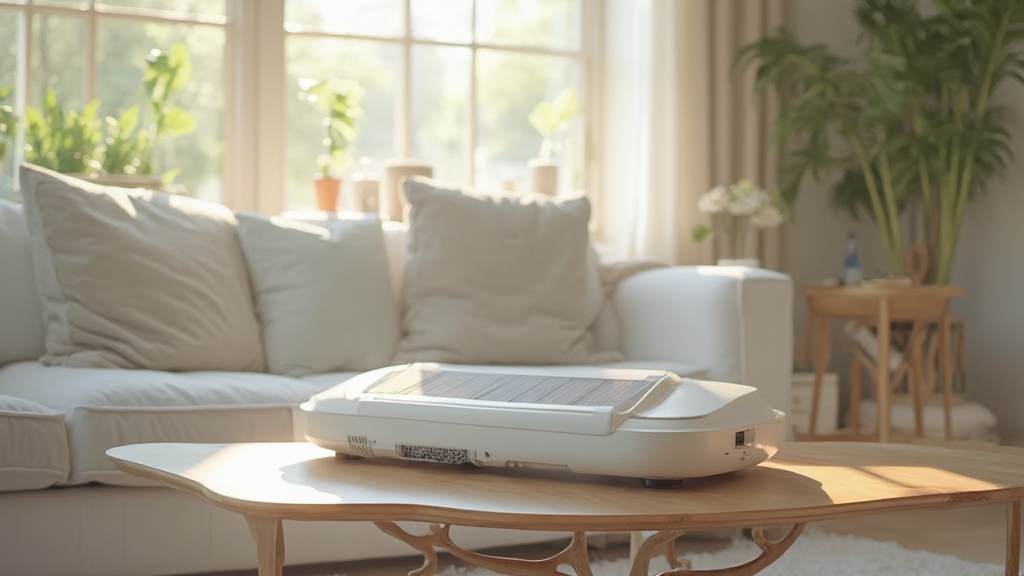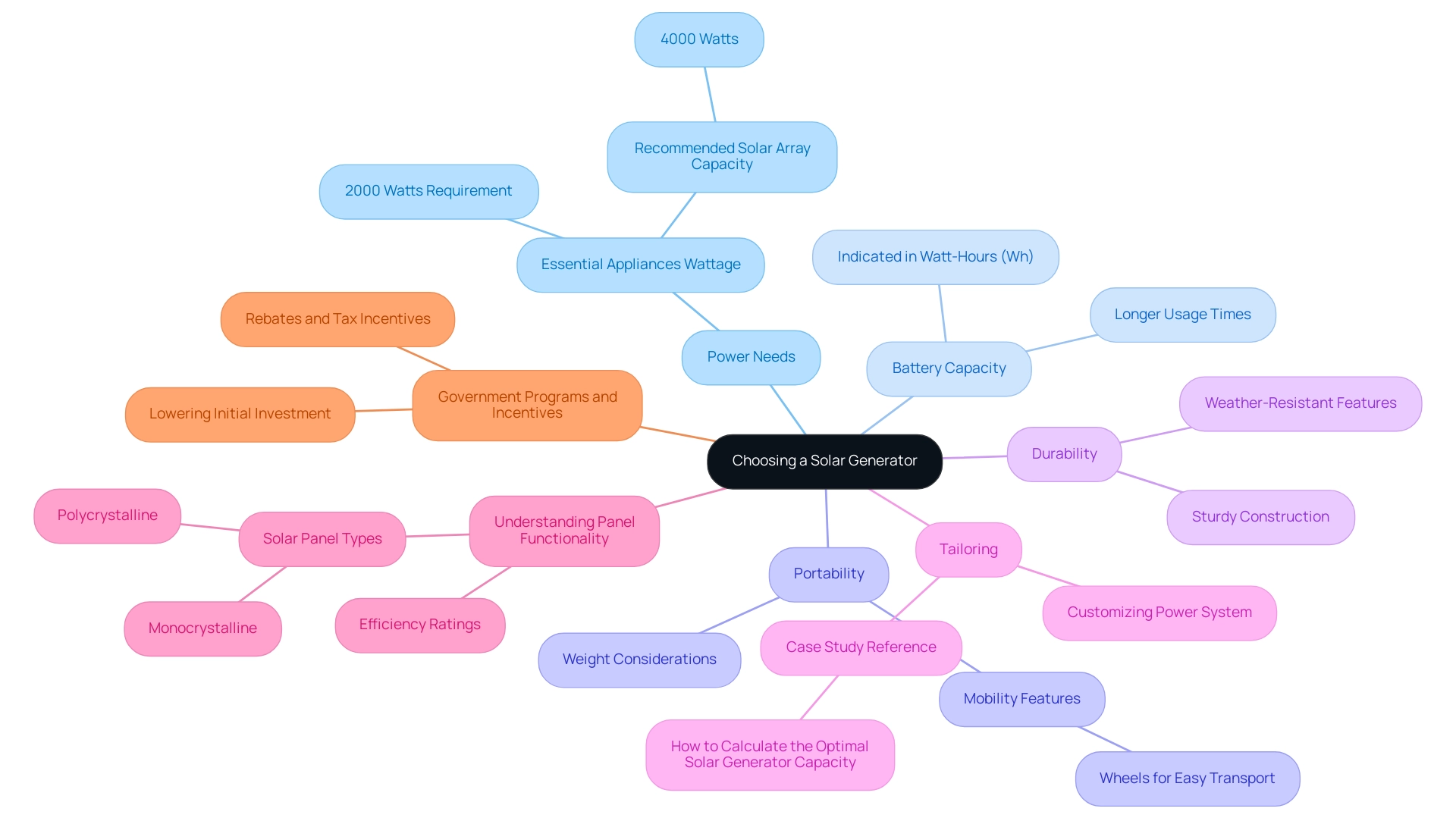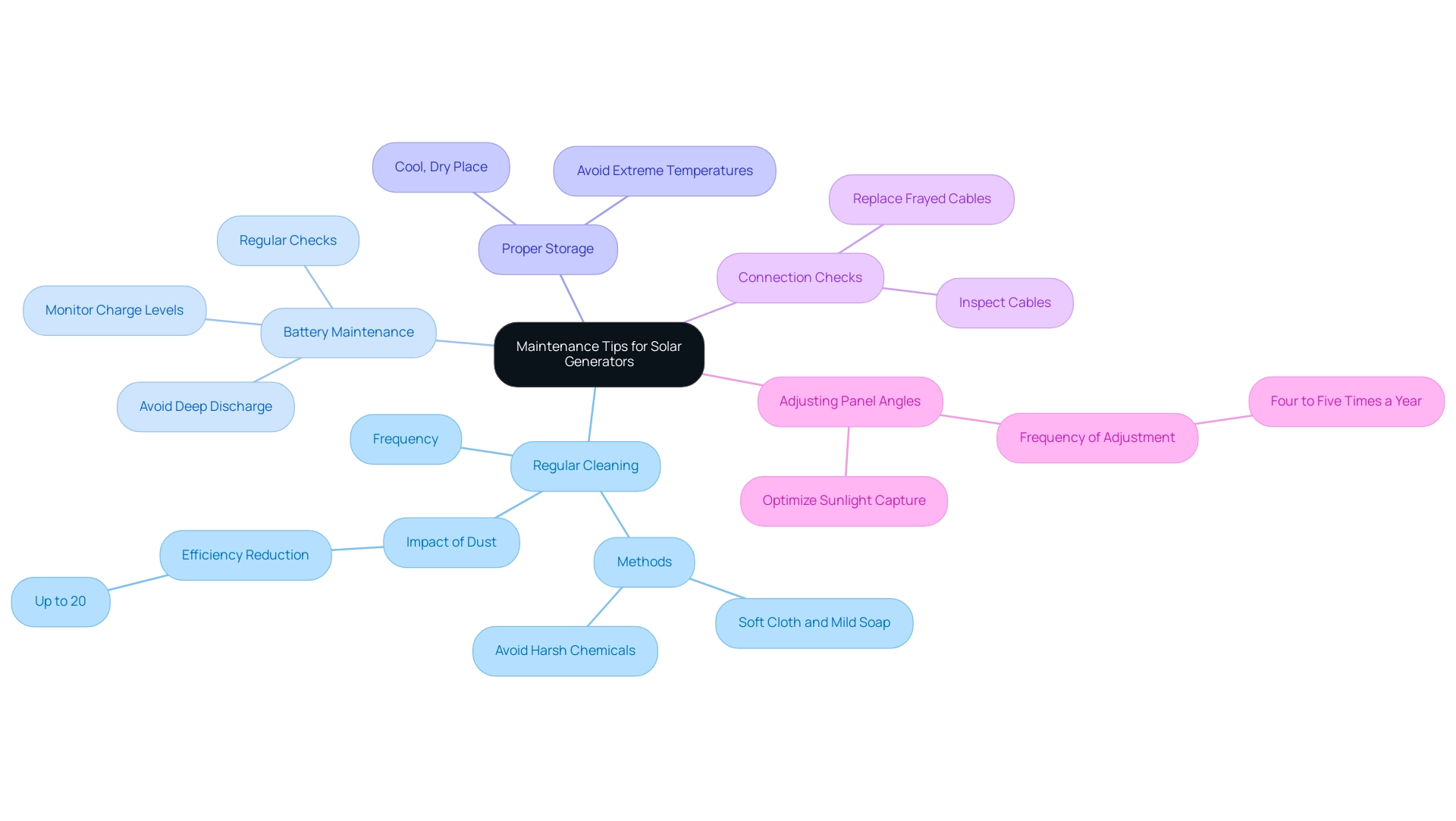Introduction
Harnessing the power of the sun has never been more accessible or essential, especially for homeowners looking to embrace sustainable energy solutions. Solar generators stand at the forefront of this green revolution, transforming sunlight into a reliable power source that can support everything from outdoor adventures to home backup during outages.
With advancements in technology enhancing efficiency and performance, understanding the intricacies of solar generators is crucial for making informed choices. This article delves into the basics of solar generators, key factors for selecting the right one, and maintenance tips to ensure longevity and optimal performance.
Whether navigating the options available or assessing energy needs, readers will find valuable insights to illuminate their journey toward a more eco-friendly lifestyle.
Understanding Solar Generators: Basics and Functionality
Solar generators are innovative devices that efficiently convert sunlight into electricity, providing a sustainable energy source without depending on traditional fuels. At their foundation, these systems include:
- Photovoltaic panels that capture sunlight
- A charge controller that regulates battery charging
- An inverter that transforms stored electricity into usable current
This trio operates harmoniously to satisfy your power requirements, whether you’re enjoying outdoor activities like camping or seeking dependable backup power for your home during outages or adverse weather conditions.
As policy analyst Ben Zientara emphasizes, understanding how these systems operate is crucial for maximizing their potential in our daily lives. Although only 0.03% of the sunlight available in the U.S. was utilized to produce electricity in 2020, the potential for this resource remains substantial, emphasizing the significance of photovoltaic systems in capturing this asset. Recent advancements in renewable energy technology have led to improved efficiency in power systems, making them even more appealing choices for eco-conscious homeowners.
With China expected to increase 334 GW of photovoltaic capacity in 2024, the worldwide transition towards renewable sources is speeding up, highlighting the importance of photovoltaic generators in today’s power landscape. Additionally, when evaluating the best battery options for efficient power storage, it’s essential to acknowledge the significance of battery backups. These backups guarantee a dependable power supply during power interruptions, improving the overall efficiency of photovoltaic systems.
A case study titled ‘Factors Influencing Brand Choice’ reveals that installers prioritize:
- Product performance
- Brand reputation
- Warranty offerings
When selecting equipment, reinforcing the credibility and reliability of renewable devices as a viable power solution for your home. Furthermore, exploring options like Tesla home chargers and understanding panel functionality can further enhance your energy experience.
Key Factors to Consider When Choosing a Solar Generator
When it comes to choosing the right solar generator for your home, there are several key factors to keep in mind to make an informed decision:
- Power Needs: Start by determining how much wattage your essential devices require. For example, if your appliances require approximately 2000 watts, strive for a machine with a capacity of roughly 4000 watts to guarantee you can manage all your energy demands at the same time. This ensures you can keep everything running smoothly without any hiccups.
- Battery Capacity: Take a close look at the battery capacity of the device, usually indicated in watt-hours (Wh). A higher capacity translates to longer usage times, allowing you to power your devices without the constant worry of recharging. This is especially essential for off-grid adventures or emergency backup plans, ensuring reliability when you need it most.
- Portability: If you’re planning to take your power source on camping trips or outdoor events, portability is crucial. Consider its weight and how easy it is to transport. Many contemporary devices come equipped with wheels for effortless mobility, making them a breeze to move around.
- Durability: Look for a power source that can withstand the rigors of outdoor use. A sturdy construction and weather-resistant features will ensure your investment holds up against the elements, providing peace of mind whether you’re at home or exploring nature.
- Tailoring: As energy policy analyst Ben Zientara emphasizes, adjusting your power system to meet your household’s specific energy needs is vital for efficient and reliable operation. This customization can lead to better performance, especially during critical times. For further assistance, explore materials such as the case study named “How to Calculate the Optimal Power Supply Capacity,” which aids you in determining the suitable size of a power source based on the particular devices and appliances you plan to charge and their usage duration.
- Understanding Panel Functionality: It’s also important to understand how panels operate in conjunction with your generator. Solar panels convert sunlight into electricity, which can be stored in batteries for later use. Get acquainted with the types of panels available, such as monocrystalline and polycrystalline, and their efficiency ratings to make an informed choice.
- Government Programs and Incentives: Don’t overlook available government programs that can assist with the cost of energy installations. Numerous states provide rebates or tax incentives for renewable power systems, which can greatly lower your initial investment.
By considering these elements, particularly designed for eco-aware homeowners and renters in Long Beach, you’ll be well on your path to understanding how to choose a solar generator that suits your lifestyle flawlessly. Furthermore, consider the significance of routine cleaning services for your panels to maintain efficiency and optimize power generation.
Exploring Different Types of Solar Generators
When it comes to solar generators, there are several types to consider, each with its own unique benefits that can be particularly useful for eco-conscious homeowners in Long Beach looking to access sustainable energy solutions:
- Portable Solar Generators: These handy devices are perfect for camping trips or outdoor adventures. Lightweight and easy to transport, they may have a lower energy output, but they excel when it comes to supplying small devices like phones, lights, or laptops. They’re all about convenience, making them an excellent choice for those spontaneous getaways.
- Stationary Energy Generators: If you’re looking for something more robust for home use, stationary energy generators are the way to go. With higher capacities, these systems can power multiple devices at once, keeping your home running smoothly during outages. Frequently linked to energy panels placed on your roof, they offer a consistent flow of clean energy, which is vital for Long Beach residents seeking to lessen their carbon footprint.
- Hybrid Energy Generators: For those who want the best of both worlds, hybrid energy generators are incredibly versatile. These units merge renewable energy with conventional fuel sources, providing versatility for any scenario. They can be particularly useful during extended outages, ensuring you have a backup plan when the grid fails.
Alongside solar generators, battery systems are essential in optimizing solar resource utilization. Solar batteries retain surplus electricity produced during the day for utilization at night or during overcast times, ensuring a reliable supply. Off-grid solutions, which enable homeowners to disconnect from the conventional electricity grid, are also gaining popularity, offering independence and resilience against outages.
Moreover, various government programs and incentives are available to renters in Long Beach interested in energy solutions. These programs can assist in reducing installation expenses and make renewable energy more accessible.
As the renewable energy market continues to grow—with a valuation of $549.2 million in 2023 and a projected CAGR of 6.54% from 2024 to 2032—understanding these choices becomes increasingly vital. As stated by Aditi Shivarkar, “The photovoltaic power market is not merely a trend, but a viable answer for numerous homeowners, guaranteeing they have access to clean power when it is most crucial.” Industry leaders such as Jackery Inc., EcoFlow Inc., SolSolution, and Bluetti are paving the way with innovative technologies, making renewable power a viable option for many.
For example, in January 2022, Bluetti introduced the sodium-ion power supply NA300, which provides thermal stability, rapid charging, and integration efficiency, highlighting progress in battery technology. This practical illustration emphasizes how innovation is influencing the future of power sources, enhancing their efficiency and usability—crucial factors for Long Beach tenants contemplating environmentally friendly alternatives. Additionally, it’s important to evaluate the benefits and drawbacks of panel shingles, which can offer a seamless integration of technology into your home’s roof design but may come with higher upfront costs and installation complexities.
Assessing Your Energy Requirements for Optimal Selection
Evaluating your power needs for a renewable system doesn’t need to be intimidating! Just follow these simple steps:
-
List Your Devices: Start by noting all the devices you wish to energize with your power source.
Think about everything from your refrigerator to your gaming console—like an Xbox One, which can consume between 50W and 110W.
-
Calculate Total Wattage: Next, check the wattage for each device. You can usually find this information on the label or in the device manual.
Add up the wattages to find your total wattage requirement. For example, if you’re planning to run a 1500W electric heater, keep in mind that it consumes 1.5 kWh per hour, leading to costs around $0.23 per hour.
-
Consider Usage Time: Now, think about how long you’ll use each device.
Multiply the wattage by the number of hours you plan to use it to calculate watt-hours (Wh). This step is crucial because it helps you truly comprehend your requirements over time.
Choose a solar generator: Finally, look for a solar generator that meets or exceeds your total watt-hour requirement.
This guarantees you have a dependable source to keep all your devices functioning seamlessly.
As you navigate this process, keep in mind that requirements can fluctuate greatly. For instance, heat pump dryers consume about 0.54 kWh per load, costing approximately $0.08 per load, which highlights the importance of considering all appliances in your calculations.
Additionally, it’s helpful to refer to case studies that provide estimated wattage requirements for common appliances, such as kitchen devices and electronics, to guide your selections.
Insights from experts can also be valuable; for example, portable battery options can effectively power devices like mattress heating pads, which are often more effective than electric blankets but can pose safety risks if misused.
For Long Beach renters looking to maximize their eco-friendly energy solutions, consider consulting comprehensive guides like ‘How Solar Panels Work on a House’ and ‘Best Solar Battery Choices for Efficient Energy Storage’ for deeper insights.
Keep all of this in mind as you plan your off-grid energy solutions for a sustainable lifestyle!
Maintenance Tips for Longevity and Efficiency of Solar Generators
To keep your solar generator running smoothly and extend its lifespan, here are some friendly tips to consider:
- Regular Cleaning: Dust and debris can significantly affect your solar panels’ efficiency, potentially reducing output by up to 20%. Therefore, it’s crucial to keep them clean. Aim to clean your panels every few months using a soft cloth and mild soap. This simple task helps ensure your panels capture as much sunlight as possible, maximizing production and supporting your sustainability goals. As one expert noted, “Did you notice a significant drop in energy production? This issue can be due to a variety of factors, with the most common being dust and debris buildup.”
- Battery Maintenance: Monitoring your battery charge levels is key. Avoid letting them dip below the manufacturer’s recommended discharge level. Regular checks can help you stay ahead of potential issues and ensure your system operates at peak performance, contributing to longer battery life.
- Proper Storage: If you’re using a portable power generator, store it in a cool, dry place when not in use. Extreme temperatures can wreak havoc on battery health, so keeping it in a stable environment helps prevent damage and maintains efficiency.
- Connection Checks: Take a moment to regularly inspect all cables and connections for signs of wear and tear. Frayed cables can lead to performance issues, so replacing them promptly can save you from bigger headaches down the line.
- Adjusting Panel Angles: It is recommended to adjust the panel angle four to five times per year based on specific conditions. This adjustment can optimize sunlight capture and enhance overall efficiency.
Additionally, researchers from the Indian Institute of Engineering Science and Technology have developed a model to estimate dust accumulation on photovoltaic panels, which is crucial for maintaining their efficiency. Understanding that environmental factors can affect photovoltaic systems is also important; for instance, warmer climates may require additional units to produce the same quantity of energy as before.
Remember, even with diligent maintenance, energy systems can encounter common issues. Awareness of these potential issues, as emphasized in the context regarding panel performance and cleaning, enables you to take proactive measures. Understanding that issues can arise despite proper maintenance can help you troubleshoot effectively, ensuring you enjoy the benefits of solar power for years to come!
Conclusion
Embracing solar generators is a significant step toward a more sustainable and resilient energy future. By understanding the basics of how these systems work, homeowners can effectively harness the sun’s power to meet their energy needs, whether for outdoor activities or as a reliable backup during outages. Key considerations, such as:
- Assessing power needs
- Battery capacity
- Portability
play a crucial role in selecting the right generator for specific lifestyles and requirements.
Exploring the different types of solar generators reveals a range of options tailored for various situations—from portable units ideal for camping to stationary systems designed to power homes during emergencies. Additionally, understanding energy requirements ensures that the chosen generator can handle the demands of essential devices, promoting efficiency and reliability.
Finally, proper maintenance practices can extend the lifespan and performance of solar generators, ensuring they continue to deliver clean energy when it’s needed most. By keeping solar panels clean, monitoring battery health, and regularly inspecting connections, homeowners can maximize their investment in solar technology. Overall, the journey toward a more eco-friendly lifestyle is not only achievable but empowering, as solar generators offer a practical solution for reducing reliance on traditional energy sources and contributing to a greener planet.




